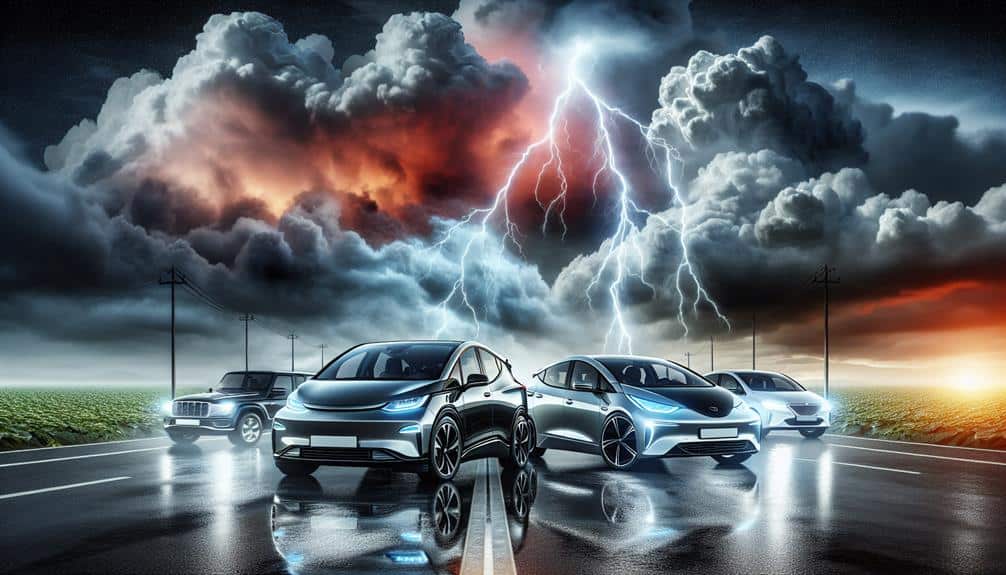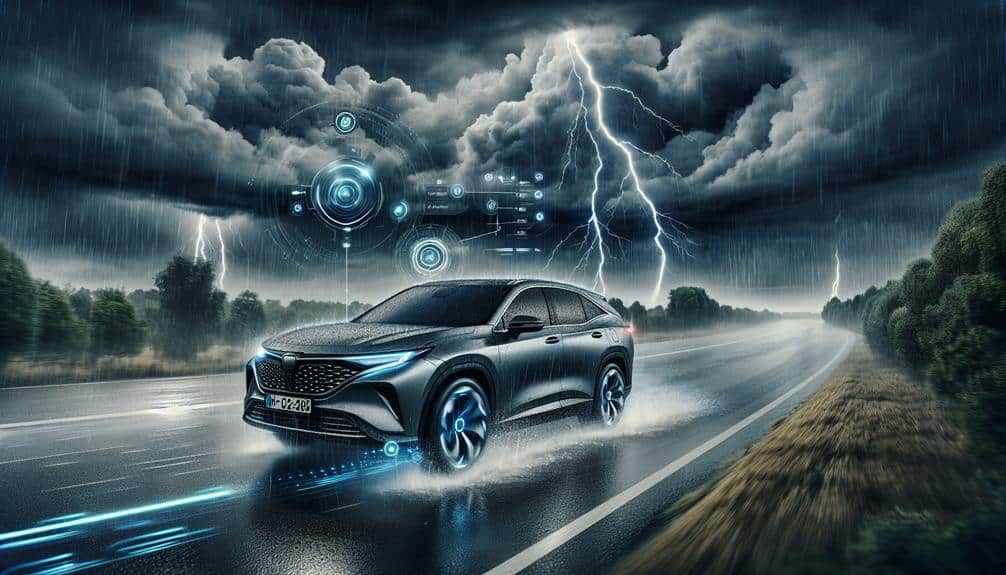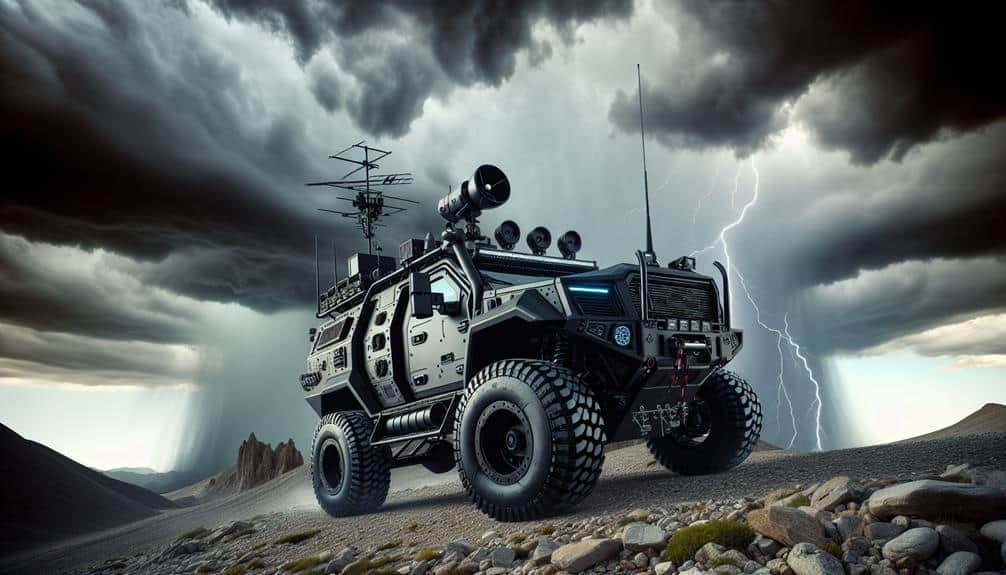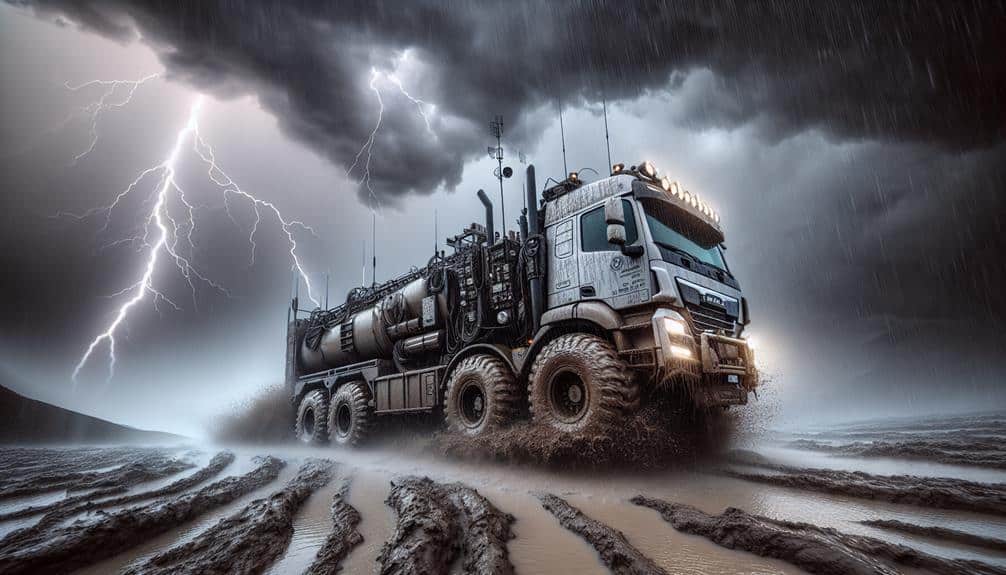As experienced storm chasers, it's important for us to select fuel-efficient cars to maximize our coverage, cut costs, and reduce environmental impact while tracking severe weather. These vehicles provide extended range per tank and lessen the necessity for frequent refueling, allowing us to cover more territory and dedicate resources toward essential equipment. Advanced stability control, real-time weather monitoring, and enhanced safety features guarantee optimal performance in extreme conditions. Moreover, reducing our carbon footprint aligns with the overarching objective of sustainability and resource preservation. Recognizing these benefits assists us in staying efficient and prepared during demanding storm-chasing missions.
Key Points
- Fuel-efficient cars reduce operating costs and environmental impact during storm-chasing missions.
- Enhanced range and mobility allow for extensive coverage with minimal fuel usage.
- Advanced navigation and real-time weather tracking improve positioning and safety.
- Longer range per tank maximizes mileage, minimizing frequent refueling stops.
Benefits of Fuel Efficiency
Fuel-saving cars allow storm chasers to cover extensive distances with minimal fuel usage, thereby reducing operating costs and environmental impact. By enhancing fuel efficiency, we maximize our range and mobility, key factors when tracking severe weather systems. This advantage enables us to respond rapidly to changing meteorological conditions, improving our ability to collect crucial data and record extreme weather phenomena.
The fuel efficiency benefits go beyond just operational flexibility. High fuel efficiency results in fewer stops for refueling, which is essential when time-sensitive opportunities arise. This allows us to spend more time chasing storms and less time looking for fuel stations, thereby increasing our chances of capturing valuable observations.
Furthermore, the environmental advantages can't be ignored. By using less fuel, we decrease our carbon footprint, aligning our actions with sustainable practices. From a technical standpoint, fuel-saving vehicles often incorporate advanced engineering, such as turbocharged engines and hybrid systems, which deliver the required power without compromising efficiency. These innovations guarantee that we've the performance necessary to navigate challenging terrains and weather conditions while maintaining optimal fuel consumption.
Therefore, the storm chasing benefits of fuel efficiency are diverse, covering operational, environmental, and performance-related advantages.
Cost Savings on Fuel
By leveraging advanced fuel-efficient technologies, we greatly reduce fuel expenses, allowing us to allocate more resources to other critical aspects of storm chasing. Efficient fuel consumption not only cuts down on costs but also maximizes mileage, giving us the freedom to cover more ground without constant refueling.
Let's break down the benefits of fuel-efficient vehicles for storm chasing:
- Money Saved: Fuel-efficient cars require less fuel to cover the same distance as traditional vehicles. This translates to immediate cost savings, reducing our overall expenditure on fuel.
- Budget Allocation: The money saved on fuel can be redirected to other essential areas such as advanced meteorological equipment, safety gear, and real-time data subscriptions, enhancing our storm-chasing capabilities.
- Operational Efficiency: With mileage maximized, we can plan longer, more flexible routes without worrying about frequent stops for refueling, which can be particularly beneficial when chasing fast-moving storms.
- Environmental Impact: Reduced fuel consumption means fewer emissions, aligning our storm-chasing activities with environmentally sustainable practices and potentially attracting sponsorships from eco-conscious organizations.
Longer Range Per Tank
A significant advantage of modern, economical vehicles is their ability to achieve longer distances per tank, allowing us to cover vast distances without the need for frequent refueling stops. This extended reach is particularly beneficial in the demanding world of storm chasing, where every minute counts, and the unpredictability of weather patterns requires quick adaptability.
Economical cars provide enhanced stamina, enabling us to stay in the field longer and chase storms farther from our starting points. This capability ensures that we can collect detailed data and maximize our observation time. Extended range also means fewer interruptions, allowing us to maintain focus on real-time analysis and decision-making.
Moreover, having a longer distance per tank translates into greater operational flexibility. We can venture into remote areas with less infrastructure, confident in our vehicle's ability to return without needing an immediate fuel station. This flexibility removes constraints, granting us the freedom to pursue storm systems wherever they develop.
Environmental Impact
When we choose fuel-efficient cars for storm chasing, we greatly reduce carbon emissions, contributing to lower atmospheric pollution.
These vehicles also aid in the conservation of finite natural resources by consuming less fuel per mile.
Reduced Carbon Emissions
Fuel-efficient cars significantly reduce the environmental impact of storm chasing by decreasing carbon emissions. As storm chasers, we recognize the crucial role our vehicles play in either worsening or easing environmental issues.
Conventional vehicles emit higher levels of greenhouse gases, leading to air pollution and hastening climate change. By choosing fuel-efficient cars, we can actively diminish our carbon footprint and advocate for sustainability.
Here are four key benefits of utilizing fuel-efficient cars for storm chasing:
- Reduced Greenhouse Gas Emissions: Fuel-efficient cars release fewer greenhouse gases, directly combating air pollution and alleviating the impacts of climate change.
- Enhanced Fuel Efficiency: These cars consume less fuel for the same distance, reducing our dependence on fossil fuels and endorsing a more sustainable approach to storm chasing.
- Lowered Operational Costs: With improved fuel efficiency, we spend less on fuel, enabling us to effectively allocate resources towards our storm chasing expeditions.
- Improved Public Perception: Utilizing eco-friendly vehicles showcases our dedication to sustainability, potentially motivating others in the storm chasing community to do the same.
Conservation of Resources
Conserving resources through the use of fuel-saving cars plays a pivotal role in minimizing the environmental impact of storm chasing. When we choose vehicles that consume less fuel, we directly contribute to reducing waste and promoting resource preservation. This isn't just about lowering our fuel expenses; it's about making conscious decisions that align with sustainable practices.
Driving fuel-saving cars means we use less gasoline or diesel, which in turn decreases the demand for these non-renewable resources. This reduced consumption translates to fewer environmental disturbances associated with extracting, refining, and transporting fossil fuels.
Additionally, fuel-saving cars often come equipped with advanced technologies that further minimize fuel wastage, ensuring that every drop of fuel is utilized efficiently.
Top Fuel-Efficient Models

Among the top fuel-efficient models ideal for storm chasing, the Toyota Prius Prime stands out due to its impressive hybrid technology and extended electric range. This hybrid option offers the flexibility of switching between electric and gas, maximizing fuel efficiency while ensuring we can cover long distances without frequent stops.
Other notable mentions include:
- Chevrolet Bolt EV: As a fully electric vehicle, the Bolt EV offers an extensive electric range, making it a powerful contender for those looking to minimize their carbon footprint while chasing storms.
- Honda CR-V Hybrid: This fuel-efficient SUV provides a robust yet economical solution, balancing the need for space and off-road capability with excellent fuel economy.
- Ford Escape Hybrid: Another hybrid SUV, the Escape Hybrid, offers a perfect blend of performance and fuel efficiency, making it an ideal choice for storm chasers who need a reliable and versatile vehicle.
- Hyundai Ioniq: Available in hybrid, plug-in hybrid, and electric versions, the Ioniq caters to a wide range of preferences, ensuring everyone can find a model that suits their needs for fuel efficiency and environmental consciousness.
Performance in Extreme Weather
When evaluating a vehicle's performance in extreme weather, we must consider factors such as drivetrain capabilities, tire traction, and the robustness of the vehicle's safety features. A fuel-efficient car, built with advanced engineering, often excels in weather resistance and speed capabilities, allowing us to navigate through severe conditions with confidence.
Drivetrain configurations like all-wheel drive (AWD) enhance stability on slippery terrain, essential during heavy rain or hail storms. Tire traction, enhanced by specialized rubber compounds and tread designs, guarantees we maintain control even when the roads are treacherous.
Durability is another cornerstone; a fuel-efficient vehicle's structural integrity must endure the mechanical strain imposed by high winds and flying debris. Reliability can't be overlooked either. These vehicles are engineered to perform consistently, reducing the risk of breakdowns when we're deep in the storm's path.
The balance of fuel efficiency and performance ensures that we can cover more ground without frequent refueling stops, crucial when chasing volatile weather patterns. By opting for a vehicle that combines weather resistance, speed capabilities, durability, and reliability, we equip ourselves to confront nature's fury with both preparedness and freedom.
Technology and Safety Features

Let's explore the essential technology and safety features that make fuel-efficient cars ideal for storm chasing.
Advanced navigation systems provide precise real-time tracking, which is vital for anticipating severe weather patterns.
Additionally, enhanced stability control guarantees peak vehicle handling, minimizing risks on slippery and uneven surfaces.
Incorporating advanced GPS and real-time weather data, cutting-edge navigation systems enhance both the efficiency and safety of storm chasing expeditions. These systems integrate multiple technologies to ensure we're always on the right path, avoiding unnecessary risks and optimizing our routes. By leveraging weather tracking capabilities, we can monitor storm patterns in real-time, allowing us to make informed decisions on-the-fly. This is essential when dealing with unpredictable weather conditions that can change rapidly.
Moreover, cutting-edge navigation systems alert us to potential road hazards, ensuring our path is clear and safe. Here's how these systems benefit us:
- Real-time Weather Tracking: Provides up-to-the-minute updates on storm movements, helping us avoid severe weather and stay in the best position.
- Dynamic Route Adjustment: Automatically recalculates our route based on current conditions, saving time and fuel.
- Hazard Alerts: Warns us about road closures, traffic jams, or other obstacles, allowing us to take alternative routes.
- Enhanced Communication: Enables seamless sharing of our location and status with team members, increasing coordination and safety.
Enhanced Stability Control
Enhanced stability management systems use advanced sensors and algorithms to maintain peak vehicle equilibrium and traction, greatly improving safety during storm chasing expeditions. These systems continuously monitor various parameters such as wheel speed, steering angle, and lateral acceleration. By detecting and correcting any deviation from best stability, they guarantee we remain in control, even under the most unpredictable weather conditions.
When maneuvering through high winds, slick roads, or sudden debris, the enhanced stability management systems provide improved handling by intervening in milliseconds. They can adjust braking force and engine power to individual wheels, preventing skidding or loss of control. This kind of precision and responsiveness is vital when we're in the thick of a storm, where every moment counts.
Moreover, these systems integrate seamlessly with other safety features like anti-lock braking systems (ABS) and traction control, forming a thorough safety net. This integration means that as we chase storms, we don't have to worry about the vehicle's performance; we can focus entirely on the task at hand.
Ultimately, the enhanced stability management systems don't just add to the safety features of our fuel-efficient cars; they empower us with the confidence to pursue our passion for storm chasing, knowing our vehicle is capable of handling whatever nature throws our way.
Frequently Asked Questions
What Are the Best Practices for Maintaining a Fuel-Efficient Car During Storm Chasing?
To keep our fuel-efficient car in top shape during storm chasing, let's keep tire pressure at its best, stay vigilant with maintenance, and adapt driving techniques to weather conditions. These steps are our lifeline in unpredictable environments.
How Do Fuel-Efficient Cars Handle Long-Distance Drives for Storm Chasing?
Fuel-efficient cars excel in long-distance drives for storm chasing by providing driving comfort and handling extreme conditions effectively. Their advanced aerodynamics and optimized powertrains guarantee we can chase storms without frequent fuel stops, maximizing our freedom.
Are There Specific Modifications to Make Fuel-Efficient Cars More Suitable for Storm Chasing?
For storm chasing, we'd install performance enhancements like turbochargers and reinforced suspension. Safety features are essential, so we add roll cages, reinforced windows, and advanced GPS systems to guarantee both reliability and safety during extreme weather conditions.
Can Fuel-Efficient Cars Accommodate All Necessary Storm Chasing Equipment?
Imagine the roar of a storm, gear packed tight. Yes, fuel-efficient cars can accommodate all necessary storm chasing equipment with smart equipment storage solutions, ensuring reduced fuel consumption without sacrificing our freedom to chase the storm.
What Insurance Considerations Should Be Taken for Fuel-Efficient Cars Used in Storm Chasing?
When considering insurance coverage for fuel-efficient cars used in storm chasing, we must make sure policies cover damage from severe weather, equipment loss, and liability. Lower fuel consumption helps reduce operational costs, but insurance remains essential.


